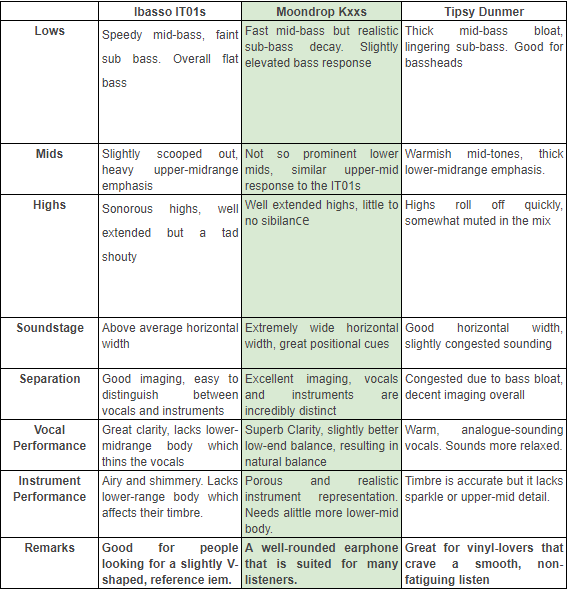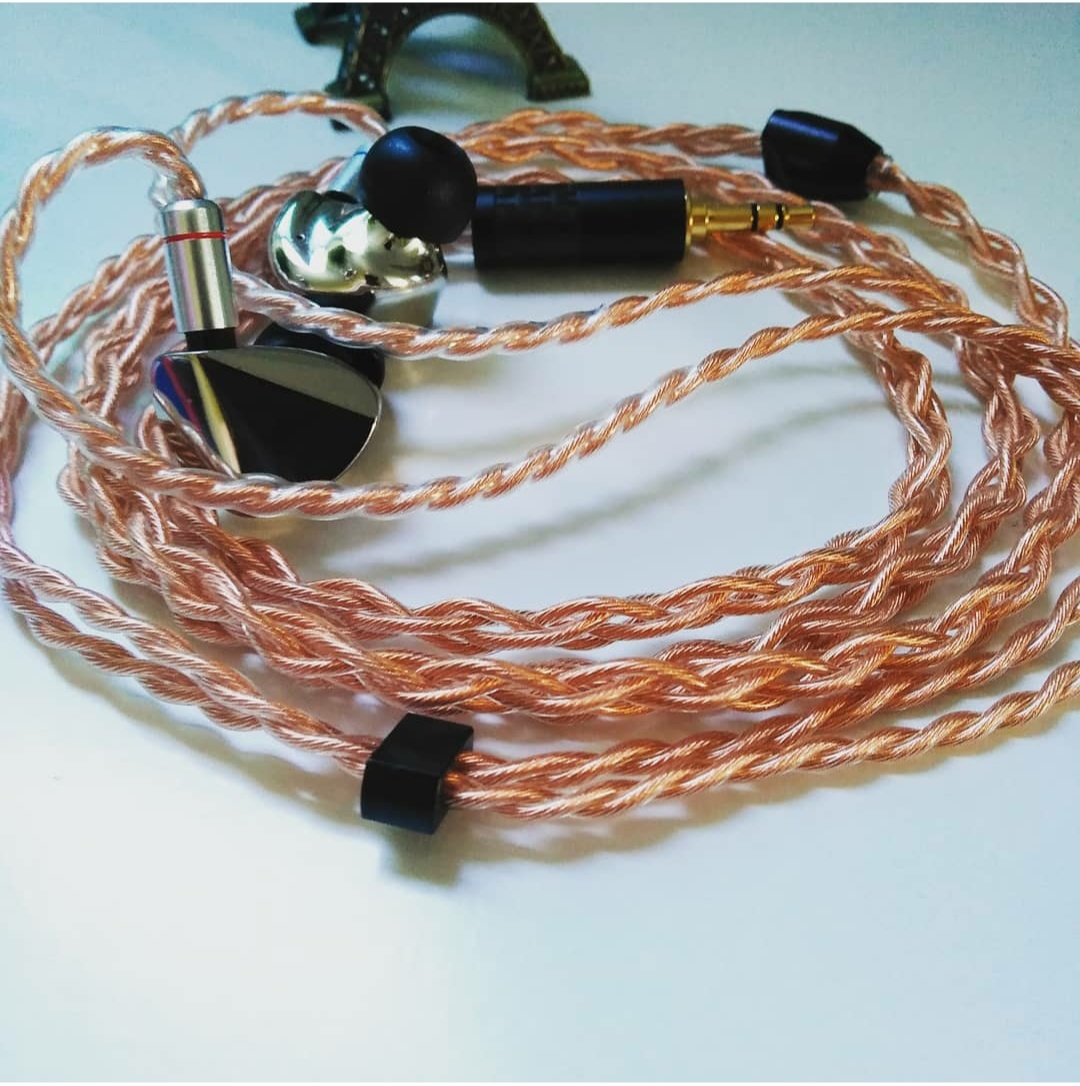Sound Review by Kev
Introduction
Disclaimer : ShenzhenAudio has graciously provided us with this sample unit in exchange for an honest review. The views discussed below are a reflection of Project A3's thoughts surrounding the product .

Moondrop Audio is a chi-fi brand that has become a rising star in the Head-fi community, famed for its value-for-money offerings. On this fine day, I’ll be reviewing the Moondrop Kxxs; the direct successor to the Kanas and Kanas Pro; earphones that have been given an early retirement despite their loyal cult following.
Like its older counterparts, the Kxxs features reworked diamond-like-carbon transducers; expensive tech often found in much more exorbitantly priced competition, such as the Campfire Audio Atlas. But the price gap between both products is staggering; the Kxxs is priced under $200 USD, whereas the Atlas is currently being sold for $899 USD. It is easily inferred that its competitive pricing established Moondrop as a serious contender in the budget-fi market, capitalizing on the trickle-down tech from its competitors.
Given the well-deserved recognition the Kanas and Kanas Pro have earned over the months, can the Kxxs satisfy the community’s already sky-high expectations? Available at
Shenzhen Audio.
 Specifcations:
Specifcations:
Diamond-like-carbon and PEEK
Detachable 2-pin cable
10Hz-80,000 Hz
110dB@1kHz Sensitivity
32 Ohms@1kHz Impedance
Gear Used & Tracklist:
Shanling M0 | Aune X1S | Periodic Audio Nickel (Ni) | Venture Electronics Odyssey | Google Pixel 2XL
 Unboxing:
Unboxing:
On first glance, the outer sleeve of the Kxxs’ box features a black-outlined print of a non-descript anime character. Behind the box, an exploded schematic of the Kxxs details what is being housed inside its shells.
Under the box, we are greeted by 3 well-organized compartments, one housing the earphones, the other accessories set and a gorgeous stamped
saffiano leather case in navy blue.
The package comes with the usual accessories set that we’ve come to expect, such as several silicon ear tips in various sizes. However, the package does include some uncommon accoutrements, such as a set of tweezers and replaceable filters, a postcard, a serialized certificate of authenticity and an extra velvet pouch. For a package that costs under $200 USD, I have to commend Moondrop for being generous at this given price point.
Scalability:
The Kxxs, with its low impedance and high sensitivity,
is easily driven out of all the sources I used for testing, without any audible hiss or interference in the foreground. Improvements were slight at best, with added width in the soundstage and a more pronounced mid-bass bump, especially with sources with high output power. Despite the high output impedance of the Aune X1s, there were no signs of hiss to be found the Kxxs.
 Fit:
Fit:
The Kxxs is built like a tank, and its heft did raise some concerns pertaining to its comfort. Despite its weight, it sat well in my ears and there was little to no rattle or movement once a good seal has been achieved. During my daily stroll towards the local train station, the earphones did not dislodge themselves out of my ear. The mirror-polished, aluminium-zinc shells are completely smooth, with no sharp extrusions to be found. However, it is worth noting that I started to notice some discomfort over extensive listening sessions.
Overall, the Moondrop Kxxs fits well in my ears, but may prove to be uncomfortable to some, given its weight.
Sound Signature:
The Kxxs is tuned similarly to the widely lauded HD800s in a miniature form-factor with a enthusiastic treble-section, offering a pristine balance between all frequencies whilst maintaining a V-shape tuning.
Bass:
Die-hard bassheads, look elsewhere; this is not a bass behemoth. However, for those interested in a bass-response that presents itself in planar-like fashion, you’ll enjoy what is being presented here. The Kxxs has a mid-bass body that while punchy, is soft enough so as to not overshadow the midrange. Sub-bass is decent, with a slight emphasis on sustain and delay for added warmth, allowing the sound signature to not sound overly clinical and sterile.
Overall, the Kxxs, while planar-like in its bass presentation, carries characteristics from both dynamic and planar magnetic drivers; the best of both worlds, without overshadowing the others.
Mids:
The mids on the Kxxs are clear and transparent, placed right in the middle of the mix. Interestingly enough, the midrange, while scooped out in order to give way to the both the highs and lows, remain distinct and tonally realistic; something that is often unheard of in most v-shaped sound signatures I’ve demoed over the years. There is ample lower-mid range warmth to accurately recreate the sonic timbre of both vocals and instrumentals. These aren’t the star of the show, but it is nevertheless, a technical feat.
Highs:
One of the Kxxs’ strength is its high-frequency response.
To my ears, the highs sound porous and again, tonally realistic. String instruments are given the wiggle-room to breathe, tapering off at the right moment when vocals start to sound rough and overbearingly sharp for treble-sensitive listeners. Even poorly mastered tracks sound tasteful on the Kxxs.
Its presentation here falls under the “pain” threshold. The Kxxs hits that acoustic sweet spot for me.
Treble:
The Kxxs succesfuly strikes a beautiful balance between accuracy and comfort in the treble region. It often dissipates quickly enough with poorly mastered tracks with a splashy treble section. However, it carries enough audible detail and forwardness to be considered clear for most listeners.
However, there is one critique to be made, and that is its strange brittle tonality. On several tracks, the treble sounds unnatural at times, especially with songs featuring unrestrained snare drums.
 Soundstage & Separation:
Soundstage & Separation:
This is what separates the Kxxs from the competition.
It HAS a massive soundstage that at times, sound like a pair of closed-back headphones. The left-right separation on the Kxxs extends far out of my ears, with each surrounding spatial cue realistically placed. Apart from the Meeaudio p1, the Kxxs to my ears, has the widest soundstage on any earphone I have had the opportunity of testing in this heavily contested price bracket.
Comparison:
While it is a breath of fresh air to see budding brands focus on the budget-fi market instead of releasing statement piece after statement piece every single year, the sub-$200 earphone market is difficult to navigate, with upstart brands churning out new releases every month. This time, I decided to pit the Ibasso IT01s and the Tipsy Dunmer with the Moondrop Kxxs; three budget giants with unique, single dynamic drivers.
Aesthetic Review by Steve

Moondrop has gain quiet a reputation in China couple of years ago, starting small and some may called it DIY, however, they've demonstrated a great example of how important of establishing a brand concept is. That's one reason how they pops up among all other brands in China. Now we are looking at their hyped one of the year KXXS and see what I think about it.
Colour:
The mirror finishing looks fine with the faceplate design. Nothing really specific to talk about since they've made a safe option on this part.
However I think they could think of making different colours instead of the typical stainless silver like the metallic Grey, champagne gold, or even copper instead like the final B series did to give customers a better option.
 Craftmanship:
Craftmanship:
Judging by the sample that I got, the gaps between shell and faceplate is acceptable for a metal structure design. You can't really expect a seamless finishing unlike the ones made out of acrylic so that you can smoothen out the edges in between.
However the lip of the nozzle is missing which might be an issue for some eartips out there. Edges on the faceplate are smooth, no spikes on any corners as well. The whole iem is well polished, making the iem look shiny and glamorous.
 Design details:
Design details:
Now this is the major point we are looking into. The mirror finishing. The cons are pretty obvious, -
a fingerprint scanner and scratches can be easily found after a period of time just like your rolex. Even if you take special care of it which I don't recommend, you will still get plenty of micro scratches under sunlight. So why bother ? another point is that I think moondrop should consider the design of the faceplate more thoughtfully , by using the mirror finishing, they should think of designing a faceplate with more surface and steeper angles making the mirror effects could be more reflective and stereoscopic. Comparing with the final B series, with the same finishing,I personally thinks the Finals did better. The current faceplate of the kxxs is a bit too plain and flat, so it might look better if they can apply some printings or sculptural elements like their logo onto it.
Silhouette:
A very rounded shape silhouette looks user friendly, matches well with the metal shell, however the weight of the iem is quiet obvious, also using metal type shells the ikko Oh10 is a bit lighter,
so if you think the IKKO Oh10 is already heavy, than this might not be for you.
Cable:
The cable itself is nicely braided, slightly on the stiff side, however the 2pin connector seem to be a bit cheap though, especially while most the brands out there use metal shell for this part. And since the kxxs used the mirror finishing, it might look much luxury for the plugs and splitter stuff to use metal parts with glossy finishing as well.
 Packaging:
Packaging:
The whole presentation looks nice and neat, well organized as well. Definitely one of the best in its category.
The case is also sturdy, chic and in good quality, practical and provides enough space even if you changed to a better cable. The only flaw IMO is the design consistency of the inner box and the cover sleeve, I understand that they wanna present a feeling of ACG type by looking at its Japanese comic style of drawing. If that's the case, then the inner box projects a very different feeling, leaning towards a minimalist designer style of package. So if they wanna make it look more consistent, a more graphical designed box and presentation seem to fit better in this case.
 Aesthetic Conclusion:
Aesthetic Conclusion:
in general the moondrop did a decent job on the Aesthetic side.
The whole presentation from package to the iem itself clearly shows their passion and effort made in this project. Not prefect but almost there, it's good enough for the price along with the sound that they made, the Kxxs is definitely worth the hyped.
Ratings: ( based on the catagory under 199usd)
Colour: 4 / 5
Craftmenship: 4.5 / 5
Design details: 4. 5 / 5
Silhouette: 4.5 / 5
Cable: 4 / 5
Packaging: 4.5 / 5
Asethetic overall rating : 4.5 / 5
Sound Conclusion:
The Moondrop the Kxxs is the people’s IEM; an earphone that meets the expectations and tastes of many a consumer, and it does it surprisingly well. Not only is it built to last, but it punches above its weight as an earphone in its highs, lows and sound-staging capabilities.
It is a powerhouse of an earphone, offering clarity that’s unheard of in this price segment, giving competitors a run for their money.
Sound overall rating : 4.5/5*
 *All ratings are accurate as of date of publication. Changes in price, newer models may affect Project A3's views on the performance and value of the reviewed product.
*All ratings are accurate as of date of publication. Changes in price, newer models may affect Project A3's views on the performance and value of the reviewed product.



































